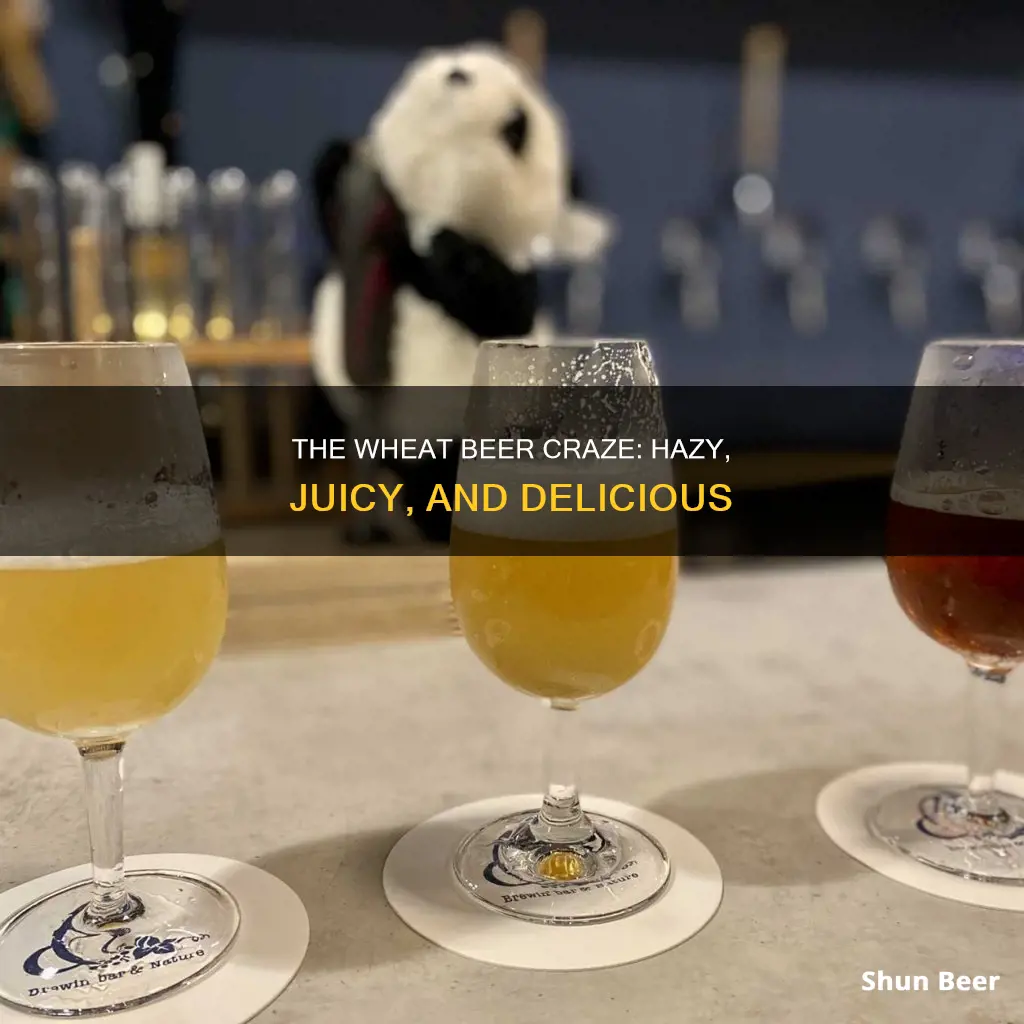
Haze in beer can be desirable and helpful in a number of styles, but it can also indicate a serious problem. Haze in beer is caused by the interruption of light passing through the liquid by particulates in suspension. Wheat beers are often hazy, as wheat imparts a higher-than-usual level of proteins in suspension in the finished beer. Haze can also be caused by the presence of yeast or polyphenols. Hazy IPAs, or New England IPAs, are a popular style of beer that is characterised by a cloudy appearance and a juicy flavour. The haze in these beers is caused by a combination of factors, including the use of oats and wheat, extensive dry hopping, and less filtering during the brewing process.
| Characteristics | Values |
|---|---|
| Appearance | Cloudy, hazy, foggy, opaque |
| Flavour | Juicy, fruity, ripe citrus, sweet |
| Bitterness | Lower than other IPAs |
| Alcohol Content | Varies, e.g. 4.6% ABV, 6.7% ABV, 8% ABV |
| Calories | Varies, e.g. 143 calories, 214 calories |
What You'll Learn
- Haze in wheat beer can be caused by wheat, hops, or bacteria
- Haze can be desirable, but it can also indicate a problem with the beer
- Hazy IPAs are characterised by a cloudy appearance and a juicy flavour
- Hazy IPAs are less bitter than other IPAs and are considered a crowd-pleaser
- Hazy IPAs are made with oats and wheat, and are fermented at higher temperatures

Haze in wheat beer can be caused by wheat, hops, or bacteria
Haze in beer can be desirable and helpful in a number of styles, but it can also signal a serious problem. It is caused by the interruption of the passage of light through a beer by particulates that are in suspension in that beer. When the light is diffused or blocked, it appears as mistiness, fog, or murkiness, and as it intensifies, it might even render a beer completely opaque.
Haze can also be an artifact of hops usage and that doesn't necessarily mean there's a problematic excess of proteins or yeast. Hops impart polyphenols, which can be visible in beer and, given the right type and amount of hops (low alpha-acid and/or aromatic hops, and lots of them), might add a touch of haze to the beer. Hops polyphenols tend to be even more visible when they clump together with proteins from the grain. Chilling beer causes the proteins and polyphenols to cluster, adding what we've come to call "chill haze," as the newly clumped particles block more light when cold even though the beer may appear quite clear at room or cellar temperature.
Bacteria, unlike yeast, are more persistent in solution and, therefore, add haze, and that's before we get to the off-flavors they can impart, which include sharp sourness, sulfur, and fecal flavors, or (if you're lucky) diacetyl or vegetal flavors. Haze can be caused by bacterial infections, which can cloud beer and ruin it with off-flavors. For example, Pediococcus damnsosus is a common brewery infection that generates large amounts of diacetyl, that unwelcome buttery taste.
Wheat Beer: How to Identify the Unique Style
You may want to see also

Haze can be desirable, but it can also indicate a problem with the beer
Haze in beer can be desirable, but it can also indicate a problem with the beer. Haze is caused by the interruption of light passing through a beer by particulates in suspension. These particulates can be proteins, yeast, or polyphenols, which are present in every beer until it is filtered. Haze can also be caused by the presence of bacteria, which will also impact the flavour of the beer.
Haze is desirable in wheat beers, which are characterised by their use of wheat in the grist. The presence of wheat imparts a higher-than-usual level of proteins in suspension in the finished beer. Wheat beers are also often fermented with very low-flocculating yeast, which remains in suspension, giving the beer a cloudy look. Haze can also be desirable in hazy IPAs, which have a lower perceived bitterness and a fruity, juicy hop character.
However, haze can also indicate a problem with the beer. Haze can be caused by bacterial infections, which can cloud the beer and ruin it with off-flavours. Haze can also be caused by the presence of large molecular substances in the beer, such as dextrin, beta-glucan, proteins, and polyphenols. These substances can undergo changes during storage and transportation, such as combination and agglutination, resulting in the formation of turbidity. Haze can also be caused by poor brewing techniques, such as inadequate cleaning and sanitation.
To fix haze in beer, brewers can try cold conditioning, filtering, or using clarifiers and fining agents. They can also try to prevent haze by choosing high-flocculating yeast, brewing with low-protein grains, and practising good brewing techniques.
Wheat Beers: Are All Brews Created Equal?
You may want to see also

Hazy IPAs are characterised by a cloudy appearance and a juicy flavour
Hazy IPAs, also known as New England IPAs (NEIPAs), are characterised by their cloudy appearance and juicy, fruity flavour. This cloudiness is caused by a combination of proteins, polyphenols, and yeast remaining in the beer.
Hazy IPAs are often brewed with grains that have a higher protein content, such as oats and wheat, which contribute to the cloudy appearance. Polyphenols, the aromatic chemical compounds that make fruits and plants smell good, are derived from the hops used in brewing. When proteins and polyphenols come together, they bind and create a haze that is not water-soluble, further contributing to the cloudy appearance.
The type of yeast selected by the brewer can also impact the haze in the final product. Some yeasts will flocculate or clump together and sink to the bottom, while others will remain more suspended throughout the liquid, creating a haze.
The hops used in Hazy IPAs are typically added later in the brewing process, during fermentation or after, in a process known as dry hopping. This helps to retain the fruity and tropical aromas of the hops, which contribute to the juicy flavour profile of the beer.
The careful planning of malt and hops, along with less filtering before packaging, results in a beer with lower perceived bitterness than other IPAs. The juicy flavour of Hazy IPAs is often described as tasting like ripe citrus, with notes of orange, pineapple, mango, passion fruit, and tangerine.
Stella Beer: Wheat-Free or Not?
You may want to see also

Hazy IPAs are less bitter than other IPAs and are considered a crowd-pleaser
Hazy IPAs are characterised by their cloudy appearance, which is caused by the interruption of light passing through the beer by particulates in suspension. This haze can be caused by proteins, yeast, polyphenols, or bacteria. Hazy IPAs are less bitter than other IPAs due to lower perceived bitterness, which can be affected by the beer's alcohol content, malt profile, and residual sugars. This is achieved by adding hops during fermentation, which unleashes more aroma and flavour without extra bitterness. The fruity hop notes tend to be more tropical and "juicy", with less bitterness than West Coast IPAs.
The haze in hazy IPAs is created by using oats and wheat, both malted and unmalted varieties, in the brewing process. The exact makeup of proteins, beta-glucans, diastatic power, and other specifications is critical to achieving the desired haze. Hazy IPAs also tend to have a higher alcohol content, which can affect the perceived bitterness of the beer.
Hazy IPAs are considered a crowd-pleaser, with their popularity suggesting that they are a welcoming style within craft beer. The lower bitterness and fruity flavours of hazy IPAs make them more accessible to a wider range of drinkers. The haze in the beer also adds to its appeal, as it hints at a fullness of flavour. The combination of a smooth mouthfeel, juicy flavours, and a cloudy appearance creates a unique and enjoyable drinking experience.
While hazy IPAs are known for their lower bitterness, it's important to note that the perception of bitterness can vary among individuals. The bitterness of a beer is measured using International Bitterness Units (IBU), but these units may not always align with the perceived bitterness. Some hazy IPAs, such as those with higher IBUs or brewed with certain yeast strains, may have a more pronounced bitterness that appeals to drinkers who prefer a stronger bitter taste.
In conclusion, hazy IPAs are less bitter than other IPAs due to their lower perceived bitterness, fruity flavours, and brewing techniques. Their cloudy appearance and smooth mouthfeel have made them a popular choice among craft beer enthusiasts, and they are considered a crowd-pleasing style. However, the perception of bitterness can vary, and some hazy IPAs may have a stronger bitter taste depending on various factors.
Wheat Beer: What's the Deal?
You may want to see also

Hazy IPAs are made with oats and wheat, and are fermented at higher temperatures
Hazy IPAs, or New England IPAs, are known for their cloudy appearance and full-bodied flavour. They are made with a combination of oats and wheat, both malted and unmalted varieties, and fermented at higher temperatures to create a hazy, juicy texture.
Oats are a key ingredient in Hazy IPAs, contributing to the haze and smooth mouthfeel that characterises the style. They add to the haziness and body of the beer, with their high protein content creating a natural haze when brewed. Flaked oats, in particular, are commonly used in the brewing process, providing a creamy texture and aiding in head retention.
Wheat is the other crucial component, with its high protein content further contributing to the haze. Both malted and unmalted wheat varieties are used, with the malted wheat adding a fruity flavour to the beer. The combination of oats and wheat creates a stable haze and a soft, silky mouthfeel that sets Hazy IPAs apart from traditional English IPAs.
To maintain the haze, Hazy IPAs are fermented at slightly higher temperatures than usual. This prevents the haze from fading, resulting in a smooth and juicy final product. The fermentation process also involves adding hops during peak fermentation, which enhances the haze and unlocks aromatic compounds from the hops.
The unique combination of oats, wheat, and fermentation techniques gives Hazy IPAs their distinctive hazy appearance and full-bodied flavour, making them a popular choice among craft beer enthusiasts.
Carlsberg Beer: Wheat-Free or Not?
You may want to see also
Frequently asked questions
Hazy and juicy are terms used to describe wheat beers, which are top-fermented beers brewed with a large proportion of wheat relative to the amount of malted barley. Haze in beer can be caused by the interruption of light passing through the beer by particulates in suspension. Haze can be desirable and helpful in a number of styles, but it can also signal a problem. Juicy is a term used to describe the quality of fruitiness in a beer.
The two main varieties of wheat beer are German Weizenbier and Belgian witbier. Other types include Lambic (made with wild yeast), Berliner Weisse (a cloudy, sour beer), and Gose (a sour, salty beer).
The obvious difference is hop character; wheat beers are not particularly hoppy. Hazy IPAs, on the other hand, are characterised by their 'juicy' hop character, with notes of orange, pineapple, passion fruit, and papaya. Wheat beers have grists that are made up of >50% malted wheat, while hazy IPAs include wheat in the grist, generally in the form of flaked/torrified wheat or flaked oats.
Haze in wheat beer is formed by the wheat itself. Haze can also be caused by the presence of yeast and proteins in suspension, which is typical of wheat beers.







